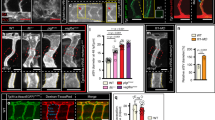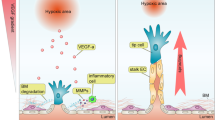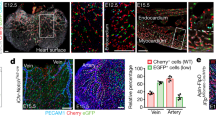Key Points
-
One of the most fundamental distinctions between blood vessels is that between arteries and veins. These two types of vessel are structurally different and have long been functionally defined by the direction of the flow of blood that they carry. Recent work indicates that the endothelial cells that line the lumens of these two vessel types have distinct molecular identities.
-
Arterial–venous endothelial-cell identity is determined during embryogenesis, before circulation begins. Recent work in several vertebrates has begun to define the molecular pathways that specify this differentiated fate. The zebrafish has been particularly useful for in vivo dissection of the signalling pathways that regulate arterial and venous fate.
-
Zebrafish provide several advantages for studying vascular development. They are amenable to large-scale forward genetics analysis. The optical clarity, external embryonic development and small size of zebrafish embryos also allow easy visualization of the vasculature and allow screening for vascular-specific mutants.
-
Components of the Notch pathway are expressed in the blood vessels of many vertebrates, and several Notch receptors are expressed specifically in arterial endothelial cells. Studies in zebrafish have now shown that the activation of Notch signalling in endothelial cells promotes arterial cell fate and represses venous differentiation.
-
Studies in the zebrafish have also shown that the well-known signalling molecules — sonic hedgehog and vascular endothelial growth factor (Vegf) — act upstream of Notch signalling to promote arterial differentiation of endothelial cells. Several recent studies in the mouse have confirmed that Vegf also has an important role in arterial specification in this organism.
-
The powerful genetic tools provided by the zebrafish will allow both the identification of other molecules that are involved in arterial differentiation and the placement of these molecules in a genetic pathway. The conservation of signalling mechanisms and the similarity of embryonic and adult neovascularization indicate that the differentiation of arterial and venous endothelial cells will probably be relevant in the context of human disease.
Abstract
Arteries and veins are structurally different and have long been functionally defined by the direction of blood flow that they carry. However, a growing body of evidence indicates that the identity of the endothelial cells that line these vessels is determined in the developing embryo, before circulation begins. Recent work on the zebrafish has led to the identification of signals that are responsible for arterial and venous differentiation of endothelial cells, and highlights the unique benefits of this model organism in the study of vascular development.
This is a preview of subscription content, access via your institution
Access options
Subscribe to this journal
Receive 12 print issues and online access
$189.00 per year
only $15.75 per issue
Buy this article
- Purchase on Springer Link
- Instant access to full article PDF
Prices may be subject to local taxes which are calculated during checkout




Similar content being viewed by others
References
Folkman, J. Angiogenesis in cancer, vascular, rheumatoid and other disease. Nature Med. 1, 27–31 (1995).
Cleaver, O. & Krieg, P. A. in Heart Development (eds Harvey, R. P. & Rosenthal, N.) 221–252 (Academic, San Diego, California, 1999).
Risau, W. & Flamme, I. Vasculogenesis. Annu. Rev. Cell. Dev. Biol. 11, 73–91 (1995).
Sabin, F. Studies on the origin of blood-vessels and of red blood corpuscles as seen in the living blastoderm of chicks on the second day of incubation. Contrib. Embryol. 36, 213–261 (1920).
Pardanaud, L., Yassine, F. & Dieterlen-Lievre, F. Relationship between vasculogenesis, angiogenesis and haemopoiesis during avian ontogeny. Development 105, 473–485 (1989).
Poole, T. J. & Coffin, J. D. Vasculogenesis and angiogenesis: two distinct morphogenetic mechanisms establish embryonic vascular pattern. J. Exp. Zool. 251, 224–231 (1989).
Wiltse, L. L. & Pait, T. G. Herophilus of Alexandria (325–255 B. C.). The father of anatomy. Spine 23, 1904–1914 (1998).
Harvey, W. in Movement of the Heart and Blood in Animals; an Anatomical Essay, 209 (Blackwell Scientific, Oxford, UK, 1957).
Clark, E. R. Studies on the growth of blood vessels in the tail of the frog larvae. Am. J. Anat. 23, 37–88 (1918).
Girard, H. Arterial pressure in the chick embryo. Am. J. Physiol. 224, 454–460 (1973).
Gonzales-Crussi, F. Vasculogenesis in the chick embryo. An ultrastructural study. Am. J. Anat. 130, 441–460 (1971).
Parry, E. W. & Abramovich, D. R. The ultrastructure of human umbilical vessel endothelium from early pregnancy to full term. J. Anat. 111, 29–42 (1972).
Wang, H. U., Chen, Z. F. & Anderson, D. J. Molecular distinction and angiogenic interaction between embryonic arteries and veins revealed by efnB2 and its receptor Eph-B4. Cell 93, 741–753 (1998).This paper describes the molecular differences between arterial and venous endothelial cells that are apparent before the onset of circulation, and suggests the existence of genetic pathways that determine these cell types.
Gerety, S. S., Wang, H. U., Chen, Z. F. & Anderson, D. J. Symmetrical mutant phenotypes of the receptor EphB4 and its specific transmembrane ligand efnB2 in cardiovascular development. Mol. Cell 4, 403–414 (1999).
Gale, N. W. et al. Ephrin-B2 selectively marks arterial vessels and neovascularization sites in the adult, with expression in both endothelial and smooth-muscle cells. Dev. Biol. 230, 151–160 (2001).
Shin, D. et al. Expression of ephrinB2 identifies a stable genetic difference between arterial and venous vascular smooth muscle as well as endothelial cells, and marks subsets of microvessels at sites of adult neovascularization. Dev. Biol. 230, 139–150 (2001).
Zhong, T. P., Childs, S., Leu, J. P. & Fishman, M. C. Gridlock signalling pathway fashions the first embryonic artery. Nature 414, 216–220 (2001).This paper provides evidence that the specification of arterial and venous endothelial identity is an early step during vascular development.
Moyon, D., Pardanaud, L., Yuan, L., Breant, C. & Eichmann, A. Plasticity of endothelial cells during arterial–venous differentiation in the avian embryo. Development 128, 3359–3370 (2001).
Othman-Hassan, K. et al. Arterial identity of endothelial cells is controlled by local cues. Dev. Biol. 237, 398–409 (2001).
Artavanis-Tsakonas, S., Rand, M. D. & Lake, R. J. Notch signaling: cell fate control and signal integration in development. Science 284, 770–776 (1999).
Del Amo, F. F. et al. Expression pattern of Motch, a mouse homolog of Drosophila Notch, suggests an important role in early postimplantation mouse development. Development 115, 737–744 (1992).
Zimrin, A. B. et al. An antisense oligonucleotide to the notch ligand jagged enhances fibroblast growth factor-induced angiogenesis in vitro. J. Biol. Chem. 271, 32499–32502 (1996).
Uyttendaele, H. et al. Notch4/int-3, a mammary proto-oncogene, is an endothelial cell-specific mammalian Notch gene. Development 122, 2251–2259 (1996).
Krebs, L. T. et al. Notch signaling is essential for vascular morphogenesis in mice. Genes Dev. 14, 1343–1352 (2000).
Xue, Y. et al. Embryonic lethality and vascular defects in mice lacking the Notch ligand Jagged1. Hum. Mol. Genet. 8, 723–730 (1999).
Uyttendaele, H., Ho, J., Rossant, J. & Kitajewski, J. Vascular patterning defects associated with expression of activated Notch4 in embryonic endothelium. Proc. Natl Acad. Sci. USA 98, 5643–5648 (2001).
Lawson, N. D. et al. Notch signaling is required for arterial–venous differentiation during embryonic vascular development. Development 128, 3675–3683 (2001).This is among the first studies to provide definitive evidence of a genetic component that determines the arterial or venous identity of blood vessels.
Villa, N. et al. Vascular expression of Notch pathway receptors and ligands is restricted to arterial vessels. Mech. Dev. 108, 161–164 (2001).
Smithers, L., Haddon, C., Jiang, Y. & Lewis, J. Sequence and embryonic expression of deltaC in the zebrafish. Mech. Dev. 90, 119–123 (2000).
Jiang, Y. J. et al. Mutations affecting neurogenesis and brain morphology in the zebrafish, Danio rerio. Development 123, 205–216 (1996).
Wettstein, D. A., Turner, D. L. & Kintner, C. The Xenopus homolog of Drosophila Suppressor of Hairless mediates Notch signaling during primary neurogenesis. Development 124, 693–702 (1997).
Lawson, N. D., Vogel, A. M. & Weinstein, B. M. Sonic hedgehog and vascular endothelial growth factor act upstream of the Notch pathway during arterial endothelial differentiation. Dev. Cell 3, 127–136 (2002).This study shows the suitability of the zebrafish for analysing signalling pathways in a series of epistasis experiments that define a genetic pathway that is responsible for arterial differentiation.
Thompson, M. A. et al. The cloche and spadetail genes differentially affect hematopoiesis and vasculogenesis. Dev. Biol. 197, 248–269 (1998).
Adams, R. H. et al. Roles of ephrinB ligands and EphB receptors in cardiovascular development: demarcation of arterial/venous domains, vascular morphogenesis, and sprouting angiogenesis. Genes Dev. 13, 295–306 (1999).
Helbling, P. M., Saulnier, D. M. & Brandli, A. W. The receptor tyrosine kinase EphB4 and ephrin-B ligands restrict angiogenic growth of embryonic veins in Xenopus laevis. Development 127, 269–278 (2000).
Stainier, D. Y. et al. Mutations affecting the formation and function of the cardiovascular system in the zebrafish embryo. Development 123, 285–292 (1996).
Weinstein, B. M., Stemple, D. L., Driever, W. & Fishman, M. C. Gridlock, a localized heritable vascular patterning defect in the zebrafish. Nature Med. 1, 1143–1147 (1995).
Zhong, T. P., Rosenberg, M., Mohideen, M. A., Weinstein, B. & Fishman, M. C. gridlock, an HLH gene required for assembly of the aorta in zebrafish. Science 287, 1820–1824 (2000).
Nakagawa, O. et al. Members of the HRT family of basic helix–loop–helix proteins act as transcriptional repressors downstream of notch signaling. Proc. Natl Acad. Sci. USA 97, 13655–13660 (2000).
Roelink, H. et al. Floor plate and motor neuron induction by different concentrations of the amino-terminal cleavage product of sonic hedgehog autoproteolysis. Cell 81, 445–455 (1995).
Ericson, J., Morton, S., Kawakami, A., Roelink, H. & Jessell, T. M. Two critical periods of Sonic Hedgehog signaling required for the specification of motor neuron identity. Cell 87, 661–673 (1996).
Fan, C. M. & Tessier-Lavigne, M. Patterning of mammalian somites by surface ectoderm and notochord: evidence for sclerotome induction by a hedgehog homolog. Cell 79, 1175–1186 (1994).
Schauerte, H. E. et al. Sonic hedgehog is not required for the induction of medial floor plate cells in the zebrafish. Development 125, 2983–2993 (1998).
van Eeden, F. J. et al. Mutations affecting somite formation and patterning in the zebrafish, Danio rerio. Development 123, 153–164 (1996).
Chen, J. N. et al. Mutations affecting the cardiovascular system and other internal organs in zebrafish. Development 123, 293–302 (1996).
Brown, L. A. et al. Insights into early vasculogenesis revealed by expression of the ETS-domain transcription factor Fli-1 in wild-type and mutant zebrafish embryos. Mech. Dev. 90, 237–252 (2000).
Carmeliet, P. et al. Abnormal blood vessel development and lethality in embryos lacking a single VEGF allele. Nature 380, 435–439 (1996).
Stalmans, I. et al. Arteriolar and venular patterning in retinas of mice selectively expressing VEGF isoforms. J. Clin. Invest. 109, 327–336 (2002).One of the first studies to show that Vegf is specifically required for arterial, but not venous, blood vessel development.
Mukouyama, Y., Shin, D., Britsch, S., Taniguchi, M. & Anderson, D. J. Sensory nerves determine the pattern of arterial differentiation and blood vessel branching in the skin. Cell 109, 693–705 (2002).The authors provide convincing evidence that Vegf is necessary for arterial differentiation and show that Vegf can directly induce artery marker gene expression without affecting endothelial cell proliferation or survival.
Visconti, R. P., Richardson, C. D. & Sato, T. N. Orchestration of angiogenesis and arteriovenous contribution by angiopoietins and vascular endothelial growth factor (VEGF). Proc. Natl Acad. Sci. USA 99, 8219–8224 (2002).
Pola, R. et al. The morphogen Sonic hedgehog is an indirect angiogenic agent upregulating two families of angiogenic growth factors. Nature Med. 7, 706–711 (2001).
Soker, S., Takashima, S., Miao, H. Q., Neufeld, G. & Klagsbrun, M. Neuropilin-1 is expressed by endothelial and tumor cells as an isoform-specific receptor for vascular endothelial growth factor. Cell 92, 735–745 (1998).
Ahn, D. G., Ruvinsky, I., Oates, A. C., Silver, L. M. & Ho, R. K. tbx20, a new vertebrate T-box gene expressed in the cranial motor neurons and developing cardiovascular structures in zebrafish. Mech. Dev. 95, 253–258 (2000).
Shutter, J. R. et al. Dll4, a novel Notch ligand expressed in arterial endothelium. Genes Dev. 14, 1313–1318 (2000).
Kudoh, T. et al. A gene expression screen in zebrafish embryogenesis. Genome Res. 11, 1979–1987 (2001).
Urness, L. D., Sorensen, L. K. & Li, D. Y. Arteriovenous malformations in mice lacking activin receptor-like kinase-1. Nature Genet. 26, 328–331 (2000).
Roman, B. L. et al. Disruption of acvrl1 increases endothelial cell number in zebrafish cranial vessels. Development 129, 3009–3019 (2002).
Odenthal, J. et al. Mutations affecting the formation of the notochord in the zebrafish, Danio rerio. Development 123, 103–115 (1996).
Fouquet, B., Weinstein, B. M., Serluca, F. C. & Fishman, M. C. Vessel patterning in the embryo of the zebrafish: guidance by notochord. Dev. Biol. 183, 37–48 (1997).
Orioli, D. & Klein, R. The Eph receptor family: axonal guidance by contact repulsion. Trends Genet. 13, 354–359 (1997).
Isogai, S., Horiguchi, M. & Weinstein, B. M. The vascular anatomy of the developing zebrafish: an atlas of embryonic and early larval development. Dev. Biol. 230, 278–301 (2001).
Motoike, T. et al. Universal GFP reporter for the study of vascular development. Genesis 28, 75–81 (2000).
Lawson, N. D. & Weinstein, B. M. In vivo imaging of embryonic vascular development using transgenic zebrafish. Dev. Biol. 249, 307–318 (2002).
Liang, D. et al. Cloning and characterization of vascular endothelial growth factor (VEGF) from zebrafish, Danio rerio. Biochim. Biophys. Acta 1397, 14–20 (1998).
Scheer, N., Groth, A., Hans, S. & Campos-Ortega, J. A. An instructive function for Notch in promoting gliogenesis in the zebrafish retina. Development 128, 1099–1107 (2001).
Scheer, N. & Campos-Ortega, J. A. Use of the Gal4–UAS technique for targeted gene expression in the zebrafish. Mech. Dev. 80, 153–158 (1999).
Nasevicius, A., Larson, J. & Ekker, S. C. Distinct requirements for zebrafish angiogenesis revealed by a VEGF-A morphant. Yeast 17, 294–301 (2000).
Liao, W. et al. The zebrafish gene cloche acts upstream of a flk-1 homologue to regulate endothelial cell differentiation. Development 124, 381–389 (1997).
Author information
Authors and Affiliations
Corresponding author
Related links
Related links
DATABASES
ArkDB
LocusLink
OMIM
haemorrhagic telangiectasia type II
ZFIN
FURTHER INFORMATION
Glossary
- LATERAL MESODERM
-
Consists of mesodermal cells that, after gastrulation, lie between the ectodermal and endodermal layers in vertebrate embryos. These cells give rise to haematopoietic, vascular and kidney tissue.
- VASCULOGENESIS
-
De novo formation of blood vessels through the coalescence of endothelial cells. It often involves extensive migration of endothelial cells from their point of origin to the site of vessel formation.
- ANGIOGENESIS
-
The formation of new blood vessels from pre-existing ones. It is often associated with cell division and the subsequent sprouting of the endothelial cells that contribute to the growing blood vessel.
- YOLK SAC
-
In mouse, the extra-embryonic tissue that surrounds the yolk.
- ANGIOBLAST
-
An undifferentiated endothelial progenitor cell that has yet to integrate into a blood vessel.
- MIDLINE
-
The notochord and its anterior extension, the prechordal plate.
- ARTERIOVENOUS MALFORMATION
-
An abnormal connection between a main artery and vein, such as the dorsal aorta and posterior cardinal vein, that leads to a circulatory bypass.
- MORPHOLINO
-
A chemically modified antisense oligonucleotide that can specifically inhibit translation of a target mRNA.
- NOTOCHORD
-
A transient structure that is located at the midline in the trunk of developing vertebrate embryos.
- NEURAL TUBE
-
Presumptive spinal cord.
- SOMITES
-
The segmental blocks of mesenchyme that are adjacent to the notochord and that give rise to the muscle tissue of the trunk.
- ARTERIOLE
-
A small-calibre artery that is continuous with a capillary network and that is associated with only one or two layers of surrounding smooth muscle cells.
- VENULE
-
A small-calibre vein that is continuous with a capillary network.
- LASER SCANNING CONFOCAL MICROSCOPE
-
A light microscope that allows imaging of fluorescent structures in thick (tens to hundreds of micrometres) specimens. A series of optical 'slices' are collected using a scanning laser beam and specially designed optics to eliminate out-of-focus excited fluorescence. The slices are reconstructed to provide detailed 3D representations of the image data.
- TELANGIECTASIA
-
A dilation of the small vessels in capillary beds that often leads to hyperpermeability and haemorrhage.
Rights and permissions
About this article
Cite this article
Lawson, N., Weinstein, B. Arteries and veins: making a difference with zebrafish. Nat Rev Genet 3, 674–682 (2002). https://doi.org/10.1038/nrg888
Issue Date:
DOI: https://doi.org/10.1038/nrg888
This article is cited by
-
Molecular and genetic mechanisms in brain arteriovenous malformations: new insights and future perspectives
Neurosurgical Review (2022)
-
miR-106a–363 cluster in extracellular vesicles promotes endogenous myocardial repair via Notch3 pathway in ischemic heart injury
Basic Research in Cardiology (2021)
-
Venous identity requires BMP signalling through ALK3
Nature Communications (2019)
-
Blood flow-induced Notch activation and endothelial migration enable vascular remodeling in zebrafish embryos
Nature Communications (2018)
-
Zebrafish mutants and TEAD reporters reveal essential functions for Yap and Taz in posterior cardinal vein development
Scientific Reports (2018)



